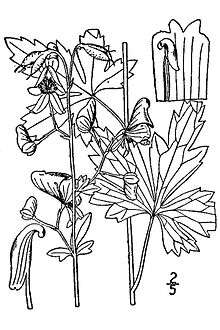Aconitum uncinatum
Aconitum uncinatum, commonly known as wild monkshood[2] or southern blue monkshood,[3] is a species of flowering plant in the buttercup family, Ranunculaceae. It grows in moist to wet habitats along streams and in woods and clearings.[2][4] It grows in the eastern United States in the Appalachian Mountains, on the Piedmont, and on the upper Atlantic Coastal Plain.[4]

Illustration of Aconitum uncinatum
| Aconitum uncinatum | |
|---|---|
_flower.jpg) | |
| Scientific classification | |
| Kingdom: | Plantae |
| Clade: | Tracheophytes |
| Clade: | Angiosperms |
| Clade: | Eudicots |
| Order: | Ranunculales |
| Family: | Ranunculaceae |
| Genus: | Aconitum |
| Species: | A. uncinatum |
| Binomial name | |
| Aconitum uncinatum | |
Toxicity and uses
The roots and seeds contain alkaloids, which are most poisonous before flowering. The plant has been used to make medicine to treat neuralgia and sciatica.[5]
References
| Wikimedia Commons has media related to Aconitum uncinatum. |
| Wikispecies has information related to Aconitum uncinatum |
- "Aconitum uncinatum L." International Plant Names Database. Retrieved 2018-04-08.
- "Aconitum uncinatum (wild monkshood)". Go Botany. New England Wildflower Society. Retrieved 2018-04-08.
- "Aconitum uncinatum". Natural Resources Conservation Service PLANTS Database. USDA. Retrieved 2018-04-08.
- Brink, D.E.; Woods, J.A. (1997). "Aconitum uncinatum". In Flora of North America Editorial Committee (ed.). Flora of North America North of Mexico (FNA). 3. New York and Oxford. Retrieved 2018-04-08 – via eFloras.org, Missouri Botanical Garden, St. Louis, MO & Harvard University Herbaria, Cambridge, MA.
- Niering, William A.; Olmstead, Nancy C. (1985) [1979]. The Audubon Society Field Guide to North American Wildflowers, Eastern Region. Knopf. p. 725. ISBN 0-394-50432-1.
This article is issued from Wikipedia. The text is licensed under Creative Commons - Attribution - Sharealike. Additional terms may apply for the media files.